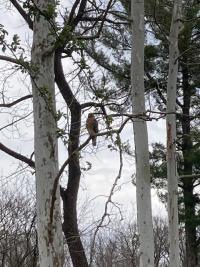 The news flickering daily on our incessant screens is nearly always heartbreaking, but last week’s report from the Intergovernmental Panel on Climate Change (IPCC) was particularly excruciating because it concerned everyone and everything we love. The IPCC found that Earth will cross a critical threshold for global warming within the next decade. The continued use of fossil fuels is dooming any possibility of slowing the warming of the planet. The panel pleaded with industrialized nations to join together immediately to slash greenhouse gases roughly in half by 2030 and to stop adding carbon dioxide to the atmosphere altogether by the early 2050s. If both these actions happened, said the panel, the Earth and her inhabitants would stand half a chance. Given the degree of international cooperation in the world and the state of governmental and political dysfunction, these pleas seem utterly unactionable.
The news flickering daily on our incessant screens is nearly always heartbreaking, but last week’s report from the Intergovernmental Panel on Climate Change (IPCC) was particularly excruciating because it concerned everyone and everything we love. The IPCC found that Earth will cross a critical threshold for global warming within the next decade. The continued use of fossil fuels is dooming any possibility of slowing the warming of the planet. The panel pleaded with industrialized nations to join together immediately to slash greenhouse gases roughly in half by 2030 and to stop adding carbon dioxide to the atmosphere altogether by the early 2050s. If both these actions happened, said the panel, the Earth and her inhabitants would stand half a chance. Given the degree of international cooperation in the world and the state of governmental and political dysfunction, these pleas seem utterly unactionable.
When such clouds descend, I go to the woods or to any nearby patch of wildness. First to Rolling Ridge. The forest still retains its winter-y beige hues, the mulch thick and rust brown underfoot; but above in the canopy the tree branches are dusted with the coral of budding leaves. The wrens and sparrows are trilling their light-hearted mating songs. Then, by the river that flows near my home, the bluebells have tiny, still mostly furled blossoms; the bloodroots are shy white stars; trillium offers three soft petals. Spicebush is decorated in tiny pale green jewels. Wherever I go, the delicate, amazing, astounding eruption of spring has begun.
When the great eco-theologian Thomas Berry was quite old, he was asked what he wanted to tell the generations coming behind him. He said:
Above all, tell them to practice an intimate presence to the beauty and wonder of the natural world through their intuitive awareness that recognizes the oneness of all life; tell them to stop and enlarge moments throughout their days to become aware of the mysteries and miracles of creation all around them – the movement of a squirrel, the sound of a bird, the pattern of a leaf, changing patterns of light, the sun, the rain, the stars, dawn and sunset. Tell them we are not ourselves without everything and everyone else.
Rebecca Solnit defines hope as uncertainty; we do not know what may happen, what different worlds await, nor our place within that future. There is always therefore opportunity to practice presence, to act. As Robin Wall Kimmerer says, we can always choose to stand on the side of life. Everywhere people are doing just that, weaving the world in which they and their children may live.
Last month I attended the American Conservation Film Festival and watched gems of documentaries about humans waking to wonder, working with habitats, streams, wetlands, harbors; using humor and empathy to change hearts and minds. There are thousands of us who will never feature in a documentary, but who tenderly plant vegetables and natives, take our grandchildren stargazing and for walks in the moonlight, and engage in a myriad of seemingly small acts of connection.
We are doing the essential work of our time, creating opportunities and spaces where we can nourish the intuitive awareness that recognizes the oneness of all life; where we can practice an intimate presence to the beauty and wonder of the natural world; where we can know an Earth who is alive and permeated with Original Presence, can feel that primal and eternal belonging: “We are not ourselves without everything and everyone else”.
This is the quiet truth that inspires the work Berry calls us to, work which may look pallid against the lurid colors of climate catastrophe, the desperate bulletins from the IPCC, the jagged letters on the wall spelling out “not enough”. It requires a ferocious courage to neither deny nor avoid nor hasten what’s to come; to live squarely and vigorously with the unknown. Martin Shaw writes:
… We have to set out into those mysteries, even with the uncertainty. Especiallywith the uncertainty. Make it magnificent. We take the adventure. Not naively but knowing this is what a grown-up does. We embark. Let your children see you do it. Set sail, take the wing, commit to the stomp. Evoke a playful boldness that makes even angels swoon. There’s likely something tremendous waiting.
This morning I took a bike ride along the old towpath of the C&O canal, beside the majestic Potomac River, robust with recent rains. It was overcast, with a slight wind that made the small, young leaves of the vines tremble and dance. In the early spring the sycamores and box elders, maples, poplars seem especially magical, the still-naked limbs flowing with possibility, on the cusp of bloom. I rolled along under the entwined arch. A movement caught my eye. It was a hawk, flying low over the water pooling in the trough of the old canal. The hawk alighted on an overhanging branch, folded her wings, and waited, eyeing the water below. I stopped. She regarded me; I regarded her. We remained like this for several minutes before the spell broke. She flew off. I pedaled on into the wind.